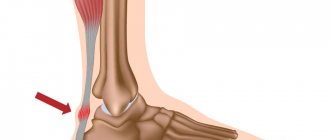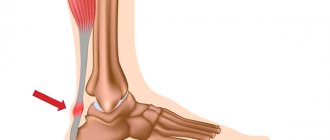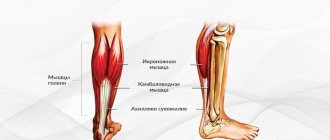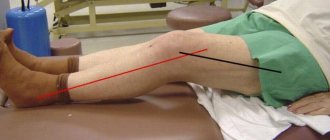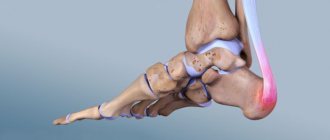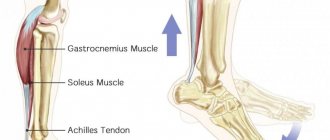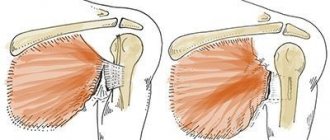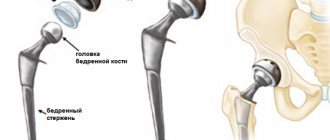While one of the strongest in the body, the Achilles tendon is also considered the most vulnerable. It is located at the junction of the back of the heel and the lower threshold of the gastrocnemius muscle. Thus, a significant part of the load when walking falls on the real ligaments. Therefore, with an incorrect, sudden movement, the Achilles tendon often ruptures.
Why does the Achilles tendon rupture?
Such gaps are often observed in people involved in sports, especially beginners. In an effort to stand out, athletes sometimes neglect precautions.
For this reason, complete rupture of the ligaments is possible. The most common injuries are:
- For runners. A sharp push at a low start can easily provoke such an injury. In this position, the tendon is exposed to exceptional danger, so you should be more careful and distribute the load correctly.
- At the jumpers. The moment the foot lifts off the support surface is also a significant risk. In the present situation, the Achilles tendon is a “spring”, which, having pushed the body out, ruptures due to unbearable gravity.
- When there is a sudden strong bending of the foot, for example, when falling on the heels. This often happens when diving into water. Therefore, it is necessary to be able to group correctly and visually assess the depth.
There is also the concept of partial rupture of the Achilles tendon. Real injury is possible when the ligaments are directly impacted by a piercing or cutting object.
Tensile Testing
The Achilles tendon does a great job of ensuring foot mobility. It connects to the calf muscle and is designed to absorb possible traumatic effects. Such impacts often occur when running or jumping, especially if a person is overweight.
Unable to withstand the load, the tendon may rupture completely or partially. The rupture is not only painful in itself, but also requires orthopedic treatment, as well as long rehabilitation after an Achilles tendon rupture to restore normal function of the foot.
If the gap is not visible to the eye, but there are suspicions, you should try to stand on your toes. Such an injury will not allow this to be done.
You can do the Achilles tendon rupture test yourself:
More clear image:
The rupture is also accompanied by swelling at the site of the ligaments, and sometimes there is hemorrhage.
Plastic surgery according to Chernavsky
Another option for surgical removal of Achilles tendon injuries is Chernavsky plastic surgery. The need for plastic surgery arises when there is severe disintegration of the ends of the Achilles, their significant divergence during muscle traction, old injuries, when serious degenerative changes and scarring have occurred in the area of impaired integrity.
During the Chernavsky operation, the patient lies in the same position as during open suturing of the tendon ends, anesthesia is similar to that for the classical type of intervention, the access is longitudinal over the defect area. After examining the tendon ends, the surgeon creates a flap from the aponeurosis of the gastrocnemius muscle up to 8 cm long and about 2 cm wide. The ends of the Achilles are brought together with threads as in a classical operation, but there may be difficulties in matching them - the distance may remain more than half a centimeter. Next, the aponeurosis flap is thrown down over the rupture site and fixed, thereby almost doubling the strength, but difficulties may arise when applying sutures due to the increased thickness of the tendon.
Achilles tendon plastic surgery according to Chernavsky
Ways to reduce the incidence of complications and surgical trauma are the use of a Kirschner wire inserted through the proximal tendon fragment, suturing the distal end of the Achilles through skin punctures in the area of the calcaneal tuberosity, and passing sutures through the calcaneal canal in case of low-lying ruptures.
In addition to Chernavsky's plastic surgery, there are other ways to strengthen the Achilles tendon - using two Lindholm tendon flaps, other tendons, and synthetic materials.
Rehabilitation methods
An Achilles tendon rupture can be treated conservatively, but if the rupture is complete, surgery may be necessary.
During the operation, the tendon is sutured with special non-absorbable materials. The method is the most effective and minimizes the risk of re-rupture.
In addition to the operating procedure, there is also a conservative method of treatment. This method involves long-term rehabilitation, excluding surgical intervention. There is no exact data on how long this may take. The result depends largely on the individual characteristics of the patient, patience and performance of all exercises.
Indications for a conservative technique are diabetes mellitus, cardiovascular and neurological diseases during exacerbation, inflammation of peripheral vessels.
However, regardless of the treatment method, there is a single recovery complex. Thus, the following are mandatory for an Achilles tendon rupture:
- exercise therapy,
- physiotherapy,
- walking exercises with crutches.
If there is a tear, it is enough to immobilize the leg with a plaster splint. Naturally, a person loses the ability to walk normally and has to use crutches or a cane, but at the initial stage, immobilization of the foot is a necessary condition for the tendon to heal. Wearing a cast for this injury is quite long - up to 10 weeks.
The rehabilitation program after an Achilles tendon rupture takes place in several stages, depending on the degree of healing of the injury.
The first stage, while the leg is still in a cast, does not involve active physical exercise and is aimed at improving blood circulation in the injured limb and preventing swelling. During this period, light exercise and massage are indicated.
After removing the cast, careful restoration of joint mobility begins. If you are overweight, it is extremely important to lose at least a little to reduce the load on your leg.
During this period, you need to start walking, about 20-25 minutes a day, and continue to massage to prevent swelling. You can contact a qualified chiropractor.
When the walking speed is already about six kilometers per hour, you can move on to slow running and exercises for multi-plane movement of the foot.
What are the consequences of refusing rehabilitation?
Failure to rehabilitate after Achilles tendon surgery can lead to a number of serious consequences.
This may be a contracture of the joint, that is, a significant restriction of the mobility of the foot, which will lead to a change in gait.
Many people who hoped that the injury would “heal on its own” cannot restore the mobility of the injured joint for the rest of their lives. Complications are possible in the form of muscle atrophy, the occurrence of adhesions at the site of rupture.
One of the most serious consequences can be deep vein thrombosis, the complications of which are life-threatening.
Classic open surgery
Open classical surgery for Achilles rupture is performed relatively rarely, since it has serious disadvantages - a high risk of complications, rough scars, a significant cosmetic defect, but with a large distance between the ends of the injured tendon, other methods may be technically impossible.
In open surgery, the patient lies on his stomach, with his foot hanging over the edge of the operating table. One type of anesthesia is performed, after which the surgeon makes a long incision above the rupture zone up to 18-20 cm. It is preferable to place the incision line more medially (inward) from the midline of the leg, since this reduces the likelihood of damage to large nerves.
open surgery
The skin and soft tissue are incised longitudinally, then the end fragments of the torn tendon are isolated, cleaned and prepared for suturing by removing non-viable areas. Both sections of the tendon are compared as closely and evenly as possible, stitched with special strong threads and pulled up with their help to the closest possible distance.
After suturing the tendon ends, additional U-shaped sutures are applied, and the soft tissues are sutured in the reverse order. If necessary, rubber drainage is left in the wound or it is sutured tightly. After surgery, it is necessary to fix the leg with a splint with moderate plantar flexion.
Video: example of surgery for Achilles rupture
Exercise therapy for tendon rupture
Exercises in the exercise therapy room should begin immediately after the cast is removed from the injured leg.
Important! It is necessary to be extremely careful about the complex, and not to do excessive exercises! This may lead to injury or re-rupture. For the first 2 weeks, you should exercise exclusively while sitting or lying down, avoiding direct pressure on the sore leg.
The main thing is to perform the exercises gradually, under the supervision of medical personnel. The attending physician himself prescribes the sequence of classes.
So, in the first two weeks the load is aimed at flexion/extension of the foot, in the third week it is recommended to start walking with the help of crutches, then exercises in the pool, squats. With an operative treatment method, after 2-2.5 months the patient will be able to move freely without support for a long time.
Additional recommendations
In order for exercise therapy for the Achilles tendon to be as effective as possible, you must adhere to several rules:
- The increase in load must be smooth and gradual. Even if you feel well, there is no need to skip the recovery stage. This will lead to serious injury, re-rupture, and possibly complete or partial failure of the ankle.
- Particular attention must be paid to shoes during recovery. It is better to give preference to sneakers with light, springy soles with a natural rise. The model should be selected exactly in size.
- If you have a dislocation or fracture, you should never try to repair the damage without the help of professionals. In 80% of cases this leads to a serious aggravation of the situation.
- It should also be noted: damage to the Achilles ligaments cannot be treated with traditional methods! Failure to see a doctor in a timely manner can significantly complicate further recovery.
- After removing the cast, you should carefully monitor the healing trend. In case of redness of the seam or local increase in temperature, you should definitely contact the clinic. These are the first signs of an infection. Small pustules in the suture area can be treated with antibacterial agents yourself.
A rupture of the Achilles tendon is an extremely unpleasant phenomenon, however, it is easily corrected. It is enough to contact a specialist in time and follow the prescribed regimen. Often recovery is delayed for many months due to a frivolous attitude towards exercise therapy gymnastics. But it is worth noting: this is one of the main factors of effective rehabilitation.
Top ↑
Exercise sets
The physical therapy complex serves for the speedy restoration of damaged ligaments. The required load depends solely on the location of the injury. Thus, if the Achilles tendon ruptures, at the initial stage of rehabilitation it is recommended to perform the following exercises in the exercise therapy room:
Sets of exercises during rehabilitation after an Achilles tendon rupture can be different, depending on the period of time that has passed since the operation.
Complex No. 1
The first complex is the most gentle and is used in the first month and a half after injury.
You can start doing exercises one week after surgery or plaster casting. Since the plaster seriously restricts movement, this complex is aimed primarily at increasing blood circulation in the affected limb.
All exercises are done sitting or lying down, without much strain and without causing pain.
- Flexion and extension of the toes in a sitting position.
- Lie on your back, legs raised and knees bent, imitating riding a bicycle.
- Lie on your stomach, bend your knees, as if throwing them back, alternately.
- Lie on your back, legs straight, try to raise your pelvis, resting on your shoulder blades and heels.
- Sitting on a chair, press the sole onto the cast without much strain.
Attention! Each exercise is performed for no longer than three minutes.
Complex No. 2
The second complex is designed for a period of one and a half to three and a half months after surgery. It should be started after the plaster has been removed.
During this period, the best exercise is careful walking. To protect the injured leg from repeated damage, you can make a heel pad in shoes made of soft materials - felt or felt.
The thickness of the lining can be varied, but not less than one and not more than four centimeters. You need to walk slowly and carefully, especially in winter. The length of the step should initially be no more than the length of the foot; subsequently, the length of the step can be gradually increased.
At home, you can build yourself a kind of exercise machine from objects that resemble a paperweight or a foot-operated sewing machine pedal. Rocking the foot with support on such objects stretches the tendon well without injuring it. Naturally, this exercise is performed in a sitting position. To the exercises from the first complex we add the following:
- Sit on a chair, feet on the floor. First, carefully raise your heels with support on your toes, then rest your entire foot on the floor. Raise your toes with support on your heels and return to the starting position again.
- When the previous exercise is easy, introduce a load. Sit on a chair, feet flat on the floor, place dumbbells weighing up to 5 kg on your hips. Raise your heels, overcoming the weight.
- Sit on a chair placed in front of a wall, raise your leg and rest against the wall, with a little tension. Perform alternately with the healthy and injured leg.
- Gradually begin to stand on your toes, raising your heels.
Examples of possible exercises
Complex No. 3
The third complex is performed in the pool when at least two months have passed since the operation. In water, body weight decreases, so movements can be performed with greater amplitude. The main exercises of this complex:
- Perform side lunges in the water while holding the handrail.
- While standing in the water, perform calf raises.
- Walking in water on toes.
- Walking with a roll from toe to heel and vice versa.
- Swimming.
Complex No. 4
The fourth complex can be described as restorative; it is performed 3.5-4 months after the injury and is aimed at normalizing the mobility of the foot to the same extent as before the injury.
During this period, the loads are close to sports, so you should switch to it only when the previous sets of exercises are given without difficulty.
The complex includes:
- Walking on a treadmill, normal and backwards.
- Lifting onto a stepper (initially holding onto a support when lifting onto the injured leg).
- Jumping rope with support alternately on the healthy and injured leg.
- Squats, holding a support, foot completely on the floor.
Additional exercises
Sitting:
- strain your toes, forming a “fist”;
- lift your toes first, then your heels;
- roll the load from heel to toe and back;
- perform rotational movements with the foot.
standing:
- without lifting your fingers from the surface, walking in place;
- holding onto the support, roll from heel to toe;
- squats on toes;
- full foot squats.
Possible exercises:
Later, the complex is supplemented with an exercise bike, exercises with weights, a treadmill with walking backwards, and exercises on a stepper. On our website in the near future you will be able to watch a video of exercise therapy after an Achilles tendon rupture. After consulting with your doctor, you can independently build an individual program based on these videos.
Rules for massage
Physical therapy exercises after an Achilles tendon rupture must be accompanied by either self-massage or seeking help from specialists. For self-massage, you will need to slowly rub your shin with your hands using smooth movements. Next, you need to place the ball under your foot and roll it with light circular movements until warmth appears.
The first weeks of rehabilitation are especially difficult. Patients often complain of swelling. To get rid of it, a professional massage is prescribed. It helps disperse blood and lymph, helps cope with tumors. Massage is performed using several methods:
- soft bilateral kneading with two hands;
- light stroking;
- circular impact with the pad of the thumb;
- by mechanical vibration.
Important! The procedure must be carried out from the bottom up. Movements should be smooth and not cause sharp pain or discomfort. If necessary, it is recommended to use special massage oil.
Complications after surgery
Following surgery for an Achilles tendon rupture, the following complications may occur:
- Rough painful scars as a result of insufficiently good surgical technique or a poorly conducted postoperative period. They can also occur when the tendon ruptures again. This can lead to limited joint movements, constant pain, and disruption of the normal walking process.
- Recurrent rupture can occur due to a violation of the postoperative regimen or due to excessive stress on the injured leg. This complication requires a repeat operation, the rehabilitation process after which is more complex and lengthy.
- Damage to the sural nerve, manifested by numbness along the edge of the foot. This complication does not cause much discomfort or pain.
- Neuroma of the foot is a benign neoplasm that can be treated quite well with medication. The discomfort that this disease causes can be eliminated with comfortable shoes and special pads.
If you follow your doctor’s recommendations in the postoperative and rehabilitation periods, you can avoid complications after an Achilles tendon rupture and return to your normal active lifestyle.
